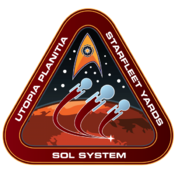Juneau class/Class Profile
| Utopia Planitia Fleet Yards |
|---|
|
EXPLORERS
Class IntroductionThe Juneau is the first of the new Juneau class, the first class of starship designed specifically for the warp XV engine and comes standard with the OR-400 Series Mark V (Oddas Rahman-400 Series Mark V) Warp Drive. A variant on the Sovereign class, it has been configured to withstand the unique stresses and systems required for the engine from the ground up. During Project Capstone, the class proved itself to be versatile, strong, and nimble - everything needed in a Starfleet vessel. Warp Drive, and Related SystemsThe biggest deviation from the Sovereign class is the aforementioned Warp XV drive. The culmination of a multi-year effort the drive can reach Warp 15, on a newly calibrated Warp Scale, but cruise at Warp 12 (equivalent to 3,956 times the speed of light and greater than warp 9.95 on the previous scale), which is ten times faster than the standard cruising speed of warp 6 (392 times the speed of light). Thus, whereas previous ships could only reach such high warp factors for 12 hours or fewer in an emergency, the Juneau can sustain this speed as part of its normal operations, far extending its long-range warp response capability and without the limitations of a cooldown period like the quantum slipstream drive. In addition, new deflectors and sensors designed specifically for use with the Warp XV drive have been installed in the Juneau, including Multiphasic Reflective Deflectors with Analytical Feedback first tested on the USS Eagle for use with Warp XV engines to better handle trips through deeper and more energetic layers of subspace. It should be noted that when running speeds of Warp 10 or higher the power requirements mean certain non-essentials, such as Astrometrics, Stellar Cartography, and others will be deprioritized. Science and ExplorationAfter its initial engine test, two full decks of the ship were configured and fitted by the Starfleet Corps of Engineers as scientific facilities. Laboratory facilities include two bio-containment labs for work with potentially dangerous specimens and easy access to the main shuttle bay. Additionally, after the successful installation and field testing onboard the Eagle, the Juneau’s Astrometrics, Stellar Cartography, Bridge, and Main Science Lab 1 will have use of the Skin Sensor node system: six high powered camera/scan nodes hardwired into the ship’s lower starboard and port sections. With a full 360 degree range of motion and a large array of scan spectrums at their disposal, the Skin Sensors will allow a higher range of scanning and study for the ship in defensive and exploration scenarios. The use of the “Spyglass” manual multi-camera control system afforded to the Main Science Lab, Astrometrics, and Stellar Cartography Lab, in which users can manually “aim” each camera either one at a time or in a hull group to suit their purposes. This control allows unprecedented precision while studying small objects and smaller regions of space from greater distance and with better precision than seen previously. A View of Why You’re ThereA novel feature of this class is found on Deck 10 where a clever use of reinforced internal bulkheads and a transparent duranium has allowed most of the deck to provide an unobstructed panorama of the stars. Encircling the entire deck this unobstructed view has been nicknamed the ‘Observation Deck’. |
- Black-and-white ship illustrations by Tim Davies unless otherwise noted. Used with permission. All other images are copyright to their respective owners.
- Black-and-white ship illustrations by Tim Davies unless otherwise noted. Used with permission. All other images are copyright to their respective owners.
| REV SD 239704.26 |
|---|

